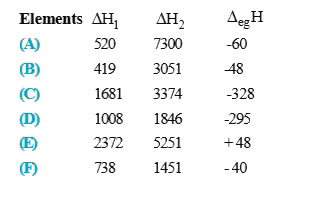Metallic radii of some transition elements are given below.

Which of these elements will have highest density ?
A
Fe
B
Ni
C
Co
D
Cu
Video Solution
Text Solution
The correct Answer is:D
Cu
|
Updated on:21/07/2023
Topper's Solved these Questions
- BOOK - MODERN PUBLICATIONCHAPTER - D AND F-BLOCK ELEMENTSEXERCISE - NCERT FILE (EXEMPLAR PROBLEM (MULTIPLE CHOICE QUESTION TYPE -II))10videos
D AND F-BLOCK ELEMENTS
- BOOK - MODERN PUBLICATIONCHAPTER - D AND F-BLOCK ELEMENTSEXERCISE - NCERT FILE (EXEMPLAR PROBLEM (SHORT TYPE QUESTION))20videos
D AND F-BLOCK ELEMENTS
- BOOK - MODERN PUBLICATIONCHAPTER - D AND F-BLOCK ELEMENTSEXERCISE - NCERT FILE (TEXTBOOK EXERCISE)38videos
D AND F-BLOCK ELEMENTS
- BOOK - MODERN PUBLICATIONCHAPTER - CHEMISTRY IN EVERYDAY LIFE EXERCISE - UNIT PRACTICE TEST13videos
CHEMISTRY IN EVERYDAY LIFE
- BOOK - MODERN PUBLICATIONCHAPTER - ELECTROCHEMISTRY EXERCISE - UNIT PRACTICE TEST20videos
ELECTROCHEMISTRY
Similar Questions
Knowledge Check
- Question 1 - Select One
Metallic radii of some transitions element are given below. Which of these elements will have highest density ?
ElementFeCoNiCuMetallic126125125128radii/pmAFeBNiCCoDCu - Question 2 - Select One
The transition elements have
Apartly filled d - orbitals and completely filled higher s - orbitalsBcompletely filled d - orbitals and partly filled higher s - orbitalsCcompletely filled d - orbitals and completely filled s - orbitalsDAll of these - Question 3 - Select One
The element which has highest density is
APdBPtCWDOs
The atomic radii of transition series elements
View SolutionThe atomic radii of transition elements in a period are.
View SolutionWhich among the following elements has the highest density?
View SolutionThe first and second ionization enthalpies and electron gain enthalpy of some elements are as given below:

Which of these elements is the most reactive metal?View SolutionThe first and second ionization enthalpies and electron gain enthalpy of some elements are as given below:

Which of these elements is the least reactive non-metal?View Solution


